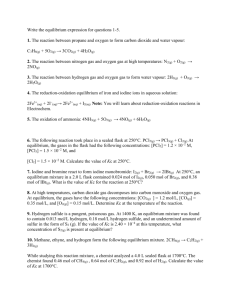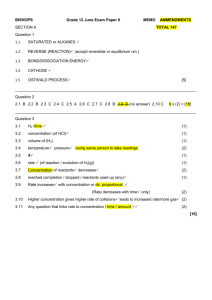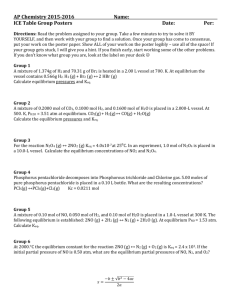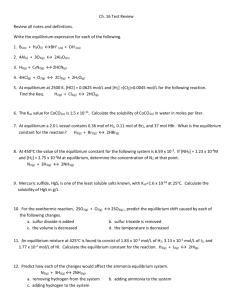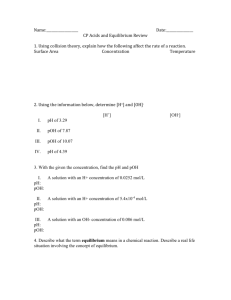Equilibrium
advertisement
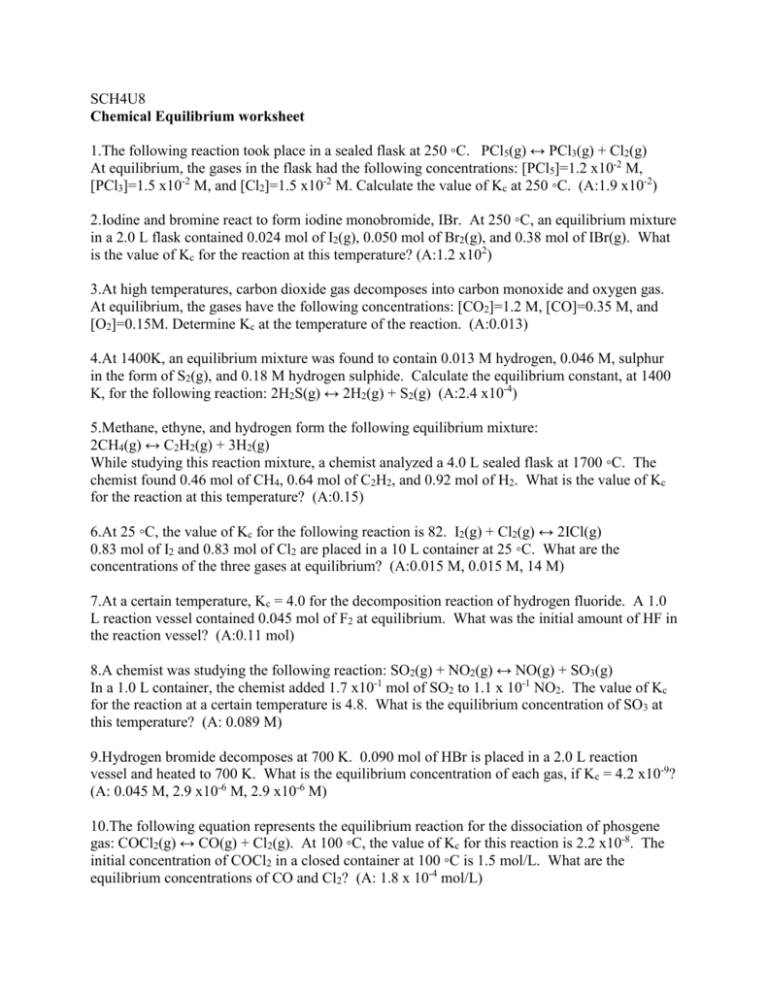
SCH4U8 Chemical Equilibrium worksheet 1.The following reaction took place in a sealed flask at 250 ◦C. PCl5(g) ↔ PCl3(g) + Cl2(g) At equilibrium, the gases in the flask had the following concentrations: [PCl5]=1.2 x10-2 M, [PCl3]=1.5 x10-2 M, and [Cl2]=1.5 x10-2 M. Calculate the value of Kc at 250 ◦C. (A:1.9 x10-2) 2.Iodine and bromine react to form iodine monobromide, IBr. At 250 ◦C, an equilibrium mixture in a 2.0 L flask contained 0.024 mol of I2(g), 0.050 mol of Br2(g), and 0.38 mol of IBr(g). What is the value of Kc for the reaction at this temperature? (A:1.2 x102) 3.At high temperatures, carbon dioxide gas decomposes into carbon monoxide and oxygen gas. At equilibrium, the gases have the following concentrations: [CO2]=1.2 M, [CO]=0.35 M, and [O2]=0.15M. Determine Kc at the temperature of the reaction. (A:0.013) 4.At 1400K, an equilibrium mixture was found to contain 0.013 M hydrogen, 0.046 M, sulphur in the form of S2(g), and 0.18 M hydrogen sulphide. Calculate the equilibrium constant, at 1400 K, for the following reaction: 2H2S(g) ↔ 2H2(g) + S2(g) (A:2.4 x10-4) 5.Methane, ethyne, and hydrogen form the following equilibrium mixture: 2CH4(g) ↔ C2H2(g) + 3H2(g) While studying this reaction mixture, a chemist analyzed a 4.0 L sealed flask at 1700 ◦C. The chemist found 0.46 mol of CH4, 0.64 mol of C2H2, and 0.92 mol of H2. What is the value of Kc for the reaction at this temperature? (A:0.15) 6.At 25 ◦C, the value of Kc for the following reaction is 82. I2(g) + Cl2(g) ↔ 2ICl(g) 0.83 mol of I2 and 0.83 mol of Cl2 are placed in a 10 L container at 25 ◦C. What are the concentrations of the three gases at equilibrium? (A:0.015 M, 0.015 M, 14 M) 7.At a certain temperature, Kc = 4.0 for the decomposition reaction of hydrogen fluoride. A 1.0 L reaction vessel contained 0.045 mol of F2 at equilibrium. What was the initial amount of HF in the reaction vessel? (A:0.11 mol) 8.A chemist was studying the following reaction: SO2(g) + NO2(g) ↔ NO(g) + SO3(g) In a 1.0 L container, the chemist added 1.7 x10-1 mol of SO2 to 1.1 x 10-1 NO2. The value of Kc for the reaction at a certain temperature is 4.8. What is the equilibrium concentration of SO3 at this temperature? (A: 0.089 M) 9.Hydrogen bromide decomposes at 700 K. 0.090 mol of HBr is placed in a 2.0 L reaction vessel and heated to 700 K. What is the equilibrium concentration of each gas, if Kc = 4.2 x10-9? (A: 0.045 M, 2.9 x10-6 M, 2.9 x10-6 M) 10.The following equation represents the equilibrium reaction for the dissociation of phosgene gas: COCl2(g) ↔ CO(g) + Cl2(g). At 100 ◦C, the value of Kc for this reaction is 2.2 x10-8. The initial concentration of COCl2 in a closed container at 100 ◦C is 1.5 mol/L. What are the equilibrium concentrations of CO and Cl2? (A: 1.8 x 10-4 mol/L) 11.Hydrogen sulphide is a poisonous gas with a characteristic offensive odour. It dissociates at 1400 ◦C, with Kc = 2.4 x10-4. H2S(g) ↔ 2H2(g) + S2(g). 4.0 mol of H2S is placed in a 3.0 L container. What is the equilibrium concentration of H2 at 1400 ◦C? (A:8.6 x10-2 mol/L) 12.At a certain temperature, the value of Kc for the following reaction is 3.3 x10-12. 2NCl3(g) ↔ N2(g) + 3Cl2(g) A certain amount of nitrogen trichloride is put in a 1.0 L reaction vessel at this temperature. At equilibrium, 4.6 x10-4 mol of N2 is present. What amount of NCl3 was put in the reaction vessel? (A:6.1 x10-5 mol) 13.At a certain temperature, the value of Kc for the following reaction is 4.2 x10-8. N2(g) + O2(g) ↔ 2NO(g) 0.45 mol of N2 and 0.26 mol of O2 are put in a 6.0 L reaction vessel. What is the equilibrium concentration of NO at this temperature? (A:1.2 x10-5 M) 14.At a particular temperature, Kc for the decomposition of carbon dioxide gas is 2.0 x10-6. 3.0 mol of CO2 is put in a 5.0 L container. Calculate the equilibrium concentration of each gas. (A: 0.59 M, 1.1 x10-2 M, 5.6 x10-3 M) 15.When 1.0 mol of ammonia gas is injected into a 5.0 L flask, the following reaction proceeds to equilibrium: 2NH3(g) ↔ N2(g) + 3H2(g). At equilibrium, 0.30 mol of hydrogen gas is present. Calculate the equilibrium concentrations of N2 and NH3, and determine the value of Kc. (A: 0.20 M, 1.6 M, 0.017)
